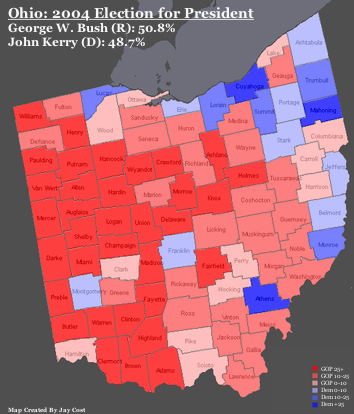
- Election Integrity
Revisiting the 2004 election. Part 3.
Still working in the holiday season—a useful change of work from hearing about Gingrich/Santorum/et al. is to remember the problems in 2004. Whoever wins the GOP nomination this year will have to do some fancy stepping to win the White House. Re past tactics, forewarned is forearmed.

- Title says it all
On March 31, 2005, a group of solidly credentialed faculty scholars and researchers released a comprehensive study of the discrepancy between exit polls, in the 2004 election, and the published vote results.
The researchers found no “statistically-plausible explanation for the discrepancy between Edison/Mitofsky’s exit poll data and the official presidential vote tally.” The irregularities in the presidential election thus posed “an unanswered question of vital national importance that demands a thorough and unblinking investigation.”
- Election Integrity
The comprehensive investigation failed to take place, although some members of Congress including Rep. John Conyers (D-Mich.) pursued inquiries. Where did the information go? Not into print in major newspapers. Not onto the airwaves. Like the U.S. Constitution, it is accessible on the Internet.
The 27-page “Analysis of the 2004 Exit Poll Discrepancies” reinforces earlier studies along the same lines, with further detail on election 2004. Authors and endorsers include professors in statistics, numerical analysis, computer studies, finance and mathematics from the U. of Utah, U. Wisconsin, Cornell, U. Pennsylvania, U. Illinois, Southern Methodist University and Notre Dame among others.
The introduction notes numerous election problems, including
- “voting machine shortages;
- ballots counted and recounted in secret;
- lost, discarded, and improperly rejected registration forms and absentee ballots;
- touch-screen machines that registered ‘Bush’ when voters pressed ‘Kerry’;
- precincts in which there were more votes recorded than registered voters;
- precincts in which the reported participation rate was less than 10%;
- high rates of ‘spoiled’ ballots and under-votes in which no choice for president was recorded;
- a sworn affidavit by a Florida computer programmer who claims he was hired to develop a voting program with a ‘back door’ mechanism to undetectably alter vote tallies.”

- Campaigning Florida-Feeney style, 2004
These authors are not political hacks, whatever that term means. They are not hired guns paid to spin election results. They are genuine experts with earned credentials in the fields of inquiry, not backgrounds in public relations. They show a scholarly and patriotic passion for the truth.
“Under such circumstances” as the problems in this election, the authors wrote,
“we must rely on indirect evidence–such as exit polls, or analysis of election result data–as a check of the overall integrity of the official election results. Without auditability or transparency in our election systems, the role of exit polls as a trigger for further scrutiny is of paramount importance.”
They conclude,
“If the discrepancies between exit poll and election results cannot be explained by random sampling error; the “Reluctant Bush Responder” hypothesis is inconsistent with the data; and other exit polling errors are insufficient to explain the large exit polling discrepancies, then the only remaining explanation – that the official vote count was corrupted – must be seriously considered.”
Regrettably, the polling company, Edison/Mitofsky, did not release all the raw data from the exit polling. Having published the exit polls–referred to in previous posts–the company went back later and changed the published exit polls to make them conform retroactively to published vote tallies. It also attempted to repudiate its own original exit polls.
The exit polls were dismissed with argument, not fact. A typical argument was that Bush voters were more reluctant to be interviewed by pollsters than were Kerry voters.
The faculty scholars make short work of this claim. As they point out,
“The Senate and presidential races were both questions on a single exit poll survey. If Bush supporters were refusing to fill out this survey as hypothesized, the accuracy of the exit poll should have been just as poor in the Senate races as it was in the presidential race. The presidential and Senate poll results derive from exactly the same responders.”
However,
“In 32 states, Senate elections took place on the same ballot with the presidential race. The exit polls were more accurate for Senate races than for the presidential race, including states where a Republican senator eventually won (pages 19-24).”
[emphasis added]
As the researchers point out, even while exit polls across the nation were being debunked as unreliable by the White House and its partisans, the accuracy of those same exit polls for Senate races was not questioned. The conclusion: “There is no logic to account for non-responders or missed voters when discussing the difference in the accuracy of results for the Senate versus the presidential races in the same exit poll.”
Nationally,
“The many anecdotal reports of voting irregularities create a context in which the possibility that the overall vote count was substantially corrupted must be taken seriously. The hypothesis that the discrepancy between the exit polls and election results is due to errors in the official election tally remains a coherent theory.”
“In fact, the burden of proof should be to show that the election process is accurate and fair. The integrity of the American electoral system can and should be beyond reproach. Citizens in the world’s oldest and greatest democracy should be provided every assurance that the mechanisms they have put in place to count our votes are fair and accurate. The legitimacy of our elected leaders depends upon it.”
Then and now, the points are unassailable:
- “Well-documented security vulnerabilities and accuracy issues have affected voting equipment” back to the 1960s.
- “The recent and ongoing proliferation of sophisticated computerized vote recording and tallying equipment” has drastically enhanced capabilities for vote-tampering.
- “That the lion’s share of this equipment is developed, provided, and serviced by partisan private corporations only amplifies these serious concerns.”
- “The fact that, in the 2004 election, all voting equipment technologies except paper ballots were associated with large unexplained exit poll discrepancies all favoring the same party certainly warrants further inquiry.”
As previously written, close-outcome states needing attention after the 2004 election included Ohio, Florida, New Mexico, and Iowa. Some of the work on these problem areas will be posted.
One example: researcher Richard Hayes Phillips did magnificent work on election problems in Toledo, Ohio.
What we need meanwhile, among other things, is for our so-called ‘backwaters’ not to be left to the tender mercies of the GOP, corporate-funded influence groups, anti-human quasi-religious organizations, and the DC political press. It is wrong to neglect small towns and rural areas.
Returning to that interesting analysis from a reader in North Carolina who compared the NC 2004 early turnout to 2000 early turnout–
In 2004, the SBOE recorded 705,462 early voters. In 2000, there had been 393,152 early voters–an increase of 312,310.
Furthermore, in 2000, early voters were 46% Democrat and 38% Republican. In 2004, early voters were 50.4% Democrat and 36% Republican. That’s a 6-point net gain in Democratic turnout.
The reader points out that one would expect John Kerry to gain “at least several percentage points over Al Gore’s showing four years ago. But when the votes were tallied, Kerry registered virtually no improvement on Gore’s vote in North Carolina (Kerry 43.6%, Gore 43.2%).”
The reader anticipates possible objections:
- Crossover voting might be a factor. But nothing indicates that crossover voting was bigger in 2004 than in 2000.
- Southerners might have voted more for Gore than for Kerry. But that does not explain why Democratic turnout increased significantly, while GOP turnout decreased.
All in all, it was reasonable to expect Kerry to perform better in North Carolina in 2004 than Gore did in 2000, even aside from the fact that John Edwards was on the ticket. Although Kerry could not have won the state, there’s still an issue.
Again–as he points out–if Kerry got 47% in North Carolina, he would have another 130,000 votes in his column. “It’s not enough to win the state’s 15 electoral votes, but a 4-point upward shift across the country is in line with the exit poll projection of a 51-48% popular vote lead for Kerry.”
Four points or less would have moved close states to Kerry, costing George W. Bush the election.








